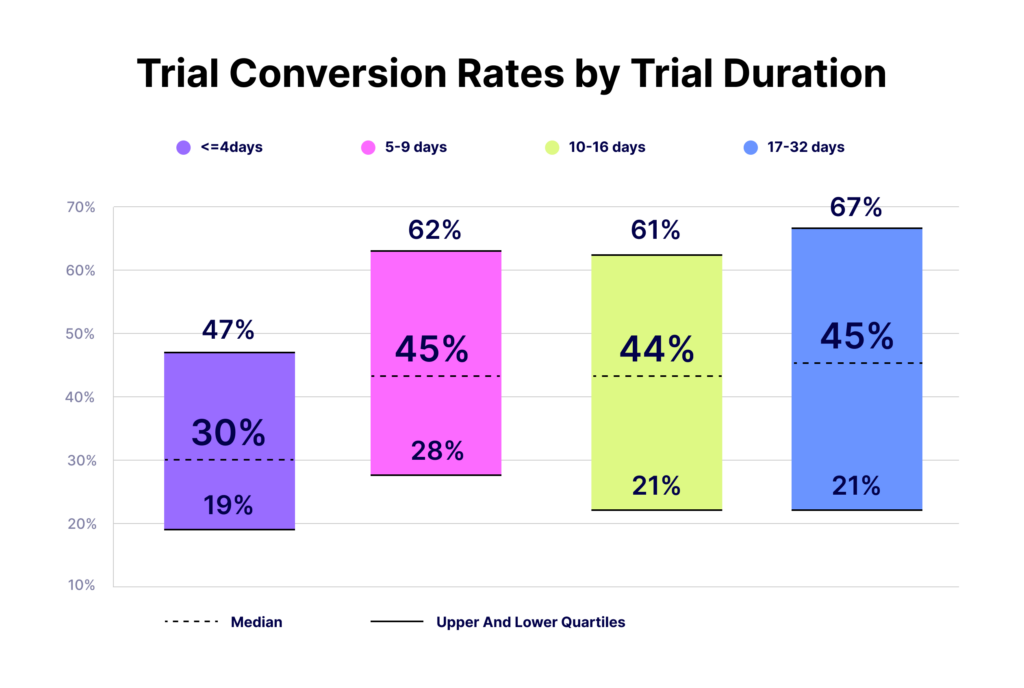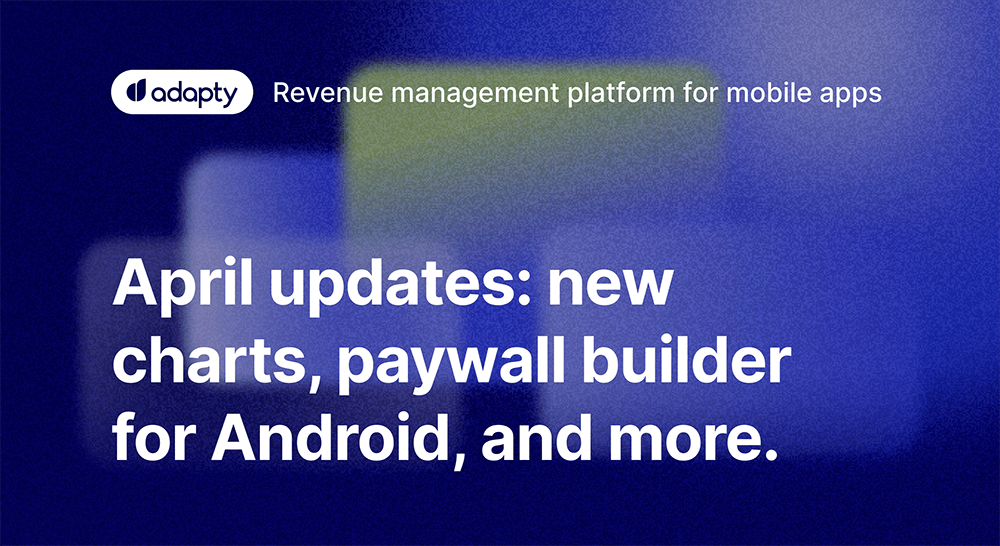Subscriptions are a staple of app monetization strategies, allowing the user to forego a hefty one-time sum in exchange for a more comfortable regular payment. However, not everyone is willing to commit to a monthly or an annual payment without having a test drive of an app or a service. That’s where the free trials come in: but even they don’t deliver a 100% success rate.
This article explains probably the most important metric for subscription apps: the free trial conversion rate. We at Adapty constantly help our customers to keep this number high with tools like Paywall Builder and A/B Price Testing. That being said, there are still some evergreen basics and industry insights we thought were worth sharing.

What is a free trial conversion rate?
The free trial conversion rate is the percentage of users who, after having used a free trial of an app, choose to become paying subscribers. This metric is crucial for evaluating the retention strategies your app employs to hold onto its users and convert them into paying customers.
A high conversion rate usually shows that users find value in the app’s premium features and are willing to pay for continued access. A low rate, on the other hand, might signify a disconnect between user expectations and the reality. Understanding this rate enables app developers and marketers to fine-tune their offers and promo strategies to maximize revenue and customer satisfaction.
How to calculate the trial conversion rate
Calculating the trial conversion rate is intuitively easy: divide the number of people who purchased the subscription after the trial by the total number of people who started the free trial in the first place. Multiplying this number by 100% will give the rate.
For example, out of 10,000 people who used the free trial, 1,200 decided to purchase the subscription. 1200/10000 * 100% gives us a 12% free trial conversion rate.

Why is it important to track your conversion rate?
Tracking your conversion rate is crucial for optimizing the monetization strategies of your app. It’s the key way to influence ROI, especially when you’re strapped for cash and on a limited promo budget.
The rate is invaluable for financial planning and revenue forecasting, helping you understand how much you can afford to invest in customer acquisition – as is, what’s the highest cost per user (CPU) you can afford — and what the expected return on that investment, ROI, might be.
Types of app free trials
There are several monetization models, each with its pros and cons. Let’s see which one works better for your app.
Freemium
The term “freemium” is a blend of “free” and “premium,” and it refers to a business model where basic services or features are provided for free, while more advanced or additional features are available at a cost. In a freemium model, there is no time limit on the free features; users can continue to use them indefinitely. The goal is to attract users with the free offerings and then upsell the premium features once they are engaged.
Limited-time free trial
In this model, users are given access to most or all of the product’s features but only for a limited period, such as 7, 14, or 30 days. After the trial period expires, users must pay to continue using the service. Limited-time free trials are designed to give prospective customers a full experience of the service, incentivizing them to become paying subscribers once they’ve seen the value it can provide.
Opt-in free trial
In this instance, users are not automatically converted to paid subscribers at the end of the free trial period. Instead, they must actively choose to continue using the service by opting into a paid subscription. If they take no action, their access to the premium features simply expires. While this approach may yield a lower conversion rate, it tends to create a subscriber base of users who are more committed, as they have made a conscious decision to continue using the service.
Opt-out free trial
In contrast, opt-out trials automatically switch users to a paid subscription after the expiration of the trial, unless the user explicitly decides not to. This model depends on the inertia of users, many of whom might continue with the paid subscription either out of satisfaction or because they forget to cancel before the trial ends. While this may lead to higher conversion rates, it can also result in customer dissatisfaction if users feel they were unknowingly charged.
Trial conversion rate benchmarks
Obviously, the higher your free trial conversion rate, the better. And there are some great cases: for example, Slack converts 30% of its free users, Vimeo converts 60%, and Netflix – a whopping 93%.
Be prepared, however, that your app might have a way lower conversion rate for a while.
Most SaaS companies enjoy a relatively low visit-to-trial rate, but higher trial-to-paid conversion rates that often range from 15% to 25%, with top-performing companies getting up to 60% of their trial users to become paid customers.
For most paid apps, the number fluctuates from 3 to 10%, depending on the necessity of the content and the availability of similar features not hidden behind a paywall. Some outliers, like Spotify, have a conversion rate of up to 46%, but here we’re talking about strong branding and evident benefits to convert like the lack of ads and the ability to download music on a device.
The matter of carefully choosing what to offer for free and what to keep paywalled is even more evident in the case of Duolingo, which, despite the industry-defining user retention techniques and worldwide recognition, has only a 5% conversion rate. Not only this app has introduced a paid tier later in its lifetime, but it also keeps the majority of its features available for free.
This number is actually a standard for most apps, with games having an even lower (around 1–2%) conversion rate. Whatever your app is, it makes sense to focus more on the growth of this metric rather than its given state. So let’s talk about how to improve this number.
Tips to improve your app’s trial conversion rate
Improving conversion rates for in-app trials involves multiple strategies that address the user experience, the value proposition, and user engagement. Here are some actionable techniques:
- Onboarding Experience: Design an intuitive and user-friendly onboarding process that quickly shows the value of your app. Use tooltips and walkthroughs to guide users through essential features.
- Value Demonstration: Make sure that users can quickly experience the value of your premium features. Place core functionalities upfront and enable easy-to-find “upgrade” options. You can also do it with different paywalls, analyzing which features, when highlighted, convert the users better.
- Time-Sensitive Offers: Leverage urgency by offering special discounts or added features if they upgrade before the trial ends. This can be particularly effective in the last few days of the trial.
- Push Notifications and Emails: Use these channels to remind users of the benefits of upgrading and the time remaining in their free trial, especially when the trial is about to end. Make the messaging compelling and personalized.
- A/B Testing: Experiment with different layouts, messages, or features exposed during the trial to see which configurations yield the highest conversion rates. Use the data to optimize your trial experience continuously. Adapty has a specific tool for A/B testing of the prices.
- Customer Support: Offer robust customer support during the trial period, even using live chats in-app to help answer questions or solve problems in real time.
- Frictionless Conversion: Make the process of moving from a free trial to a paid subscription as simple as possible. Avoid asking for unnecessary information, and make the transition seamless.
- Track Engagement Metrics: Monitoring how users interact with your app can provide insights into what might persuade them to convert. Features that see heavy usage during trials are your main selling points.
- Retargeting Campaigns: Use data analytics to identify users who didn’t convert and retarget them with special offers or surveys that can give insights into why they chose not to subscribe.
- Analyze Churn Data: Examine the reasons why users decide not to convert after the free trial. Use this data to address issues in your app or its value proposition.
By implementing these strategies and continuously monitoring their impact through relevant KPIs, such as the trial conversion rate and the churn rate, you can significantly grow your app revenue.
Conclusion
The trial conversion rate is a critical metric for any business offering in-app trials as part of its monetization strategy. It serves as a valuable indicator of the effectiveness of your trial in turning users into paying customers. Tracking this KPI, along with related metrics like Customer Acquisition Cost (CAC), Lifetime Value (LTV), and Churn Rate, offers a holistic view of your app’s performance.
Employ strategies such as optimizing the onboarding experience, leveraging time-sensitive offers, and conducting A/B testing to enhance your conversion rates. A data-driven approach and continual iterations based on performance metrics will help you fine-tune your app to maximize both customer satisfaction and revenue. So, if you’re looking to make the most out of your in-app trials, focusing on improving your trial conversion rate should be a top priority.




